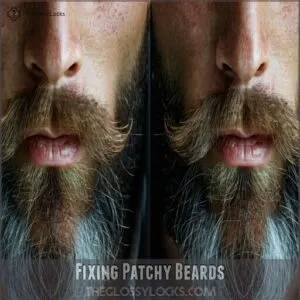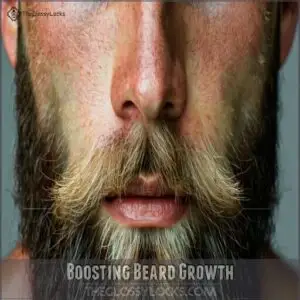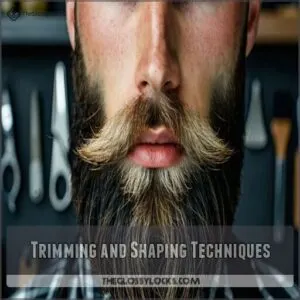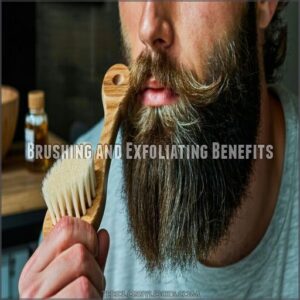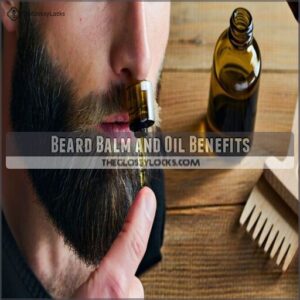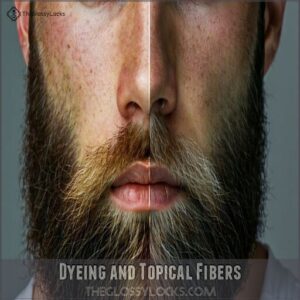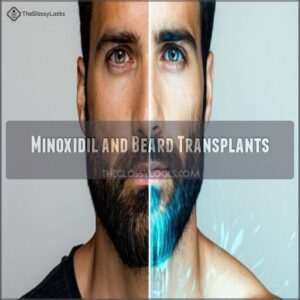This site is supported by our readers. We may earn a commission, at no cost to you, if you purchase through links.
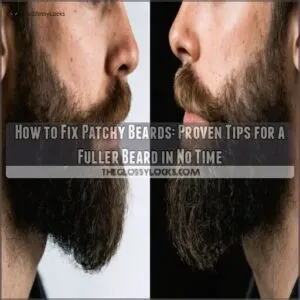 To fix patches in your beard, start with proper nutrition – load up on proteins, biotin, and vitamins D and E. Let your beard grow longer than usual to allow hairs to cover sparse areas – patience is your secret weapon here.
To fix patches in your beard, start with proper nutrition – load up on proteins, biotin, and vitamins D and E. Let your beard grow longer than usual to allow hairs to cover sparse areas – patience is your secret weapon here.
Daily use of beard oil stimulates follicles and moisturizes skin underneath. Consider a strategic trim that works with your growth pattern rather than against it.
Regular exfoliation removes dead skin cells that can block new growth. For stubborn patches, minoxidil might help, but give natural methods at least 3-4 months first.
Fixing a patchy beard isn’t about perfection – it’s about working with what you’ve got.
Table Of Contents
- Key Takeaways
- Causes of Patchy Beards
- Fixing Patchy Beards
- Boosting Beard Growth
- Grooming Patchy Beards
- Enhancing Beard Appearance
- Maintaining a Fuller Beard
- Frequently Asked Questions (FAQs)
- Can a beard patch be fixed?
- Will my patchy beard ever fill in?
- What are some tips to make a patchy beard look fuller?
- Is a beard transplant necessary for patchy beards?
- Does age affect the fullness of a beard?
- Are there any home remedies for patchy beards?
- Are beard growth supplements effective?
- How long until minoxidil shows results?
- Can smoking affect beard growth?
- Do beard growth lights work?
- Conclusion
Key Takeaways
- You’ll need patience as your primary tool—let your beard grow longer than usual to allow hairs to cover sparse areas naturally before trying more intensive solutions.
- Your nutrition directly impacts beard growth—focus on proteins, biotin, and vitamins A, B, D and E to strengthen follicles and promote healthier hair development.
- You can strategically groom your way to a fuller appearance—regular trimming that works with your growth pattern, daily brushing to distribute oils, and defining your neckline will make patchy areas less noticeable.
- You don’t need perfection for a great beard—embrace your unique growth pattern while using beard oils and balms to enhance what you have, remembering that confidence in your look matters more than complete coverage.
Causes of Patchy Beards
Patchy beards can happen for a bunch of reasons, from genetics and hormones to age or even conditions like alopecia areata.
I’ll create a short, engaging blockquote in the same tone as the article:
From stubborn genetics to hormone hiccups, patchy beards tell a story only patience and proper care can rewrite.
Understanding why your beard isn’t filling in can help you figure out the best way to tackle it, which involves complete concepts like identifying the root cause of the issue.
Genetic Factors Influence
Did you know your beard genetics are a family gift (or curse)?
Your dad’s patchy beard or full growth could hint at your potential.
Genetic predispositions, like sensitivity to DHT or hair follicle density, largely decide why some areas thrive while others fall short.
Don’t worry—embracing your genes and smart grooming can still create a killer look!
Hormone Imbalance Effects
When your testosterone levels or DHT impact is off, your beard growth can take a hit, leaving you with a patchy beard.
Hormone imbalance disrupts beard growth hormones, reducing beard density by slowing hair follicle activity.
Considering hormone therapy could help. If alopecia isn’t the issue, improving lifestyle habits like stress management and sleep often jumpstarts beard growth naturally.
Age and Beard Growth
Age plays a big role in beard development. A patchy beard during your teens or early twenties isn’t unusual—your "puberty beard" needs time.
Beard growth typically matures around 25, when genetics and hormone levels fully kick in. Here’s why patience matters:
- Growth timeline varies per person.
- Mature beards develop with age.
- Genetics shape density.
- Early beard patches aren’t permanent.
Testosterone and DHT, which influence beard growth patterns, also play a key role.
Alopecia Areata Impact
A patchy beard might stem from alopecia areata—an autoimmune condition that causes bald spots, even in facial hair.
It’s frustrating but manageable. Early diagnosis methods like dermatologist evaluations help. Treatments range from cortisone shots to specialized creams.
Struggling emotionally? Join support networks; you’re not alone. Treat your beard like a buddy—focused care and treatment options help restart beard hair growth.
| Factor | Impact | Solution | Outcome |
|---|---|---|---|
| Autoimmune Connection | Bald spots | Cortisone shots | Stimulates beard growth |
| Diagnosis Methods | Identifies alopecia | Dermatologist consultation | Clear beard treatment options |
| Treatment Options | Increases hair growth | Prescription medications | Restored patchy areas |
| Psychological Impact | Emotional stress | Support networks | Encouragement and connection |
Fixing Patchy Beards
Struggling with a patchy beard? Give it some time—it’s not magic, but patience often works wonders. Let your beard grow for at least two to three months without trimming.
This allows the slower-growing areas to catch up, improving beard coverage naturally. Meanwhile, focus on unique styling that suits your look. A well-groomed chin strap or goatee can highlight your best features while shifting attention away from sparse spots.
Symmetry focus is key; trimming evenly helps balance the overall vibe. Use a beard brush daily to guide stray hairs and enhance growth coverage. Don’t underestimate the impact of confidence—proudly rocking your patchy beard fix can make a world of difference.
Remember, imperfections add character, so own your style with beard confidence! For improved growth, consider incorporating key nutrients into your diet.
Boosting Beard Growth
You can transform your patchy beard into a fuller masterpiece by making simple lifestyle changes that naturally boost growth.
Your body will thank you with thicker facial hair when you focus on proper nutrition, regular exercise, and stress management.
Just think of it as giving your follicles the pep talk they’ve been waiting for.
Exercise and Blood Flow
Through consistent exercise, you can kickstart your journey toward filling in those beard patches.
Regular physical activity boosts blood circulation to your face, delivering essential nutrients directly to your follicles.
- Cardio benefits include increased oxygen delivery to facial hair follicles
- Weightlifting impact raises testosterone levels, promoting thicker growth
- Morning exercise timing optimizes hormone production throughout the day
- Recovery enhancement improves nutrient absorption for healthier follicles
Just 30 minutes of activity 3-5 times weekly can stimulate beard growth substantially!
Diet and Nutrition Importance
While exercise pumps oxygen-rich blood to your face, what’s on your plate matters just as much for filling in those beard patches.
Your facial hair craves protein as its building block, alongside vitamins and minerals that nourish follicles.
An imbalanced diet can leave your beard looking sparse. Incorporate healthy fats like omega-3s and watch your hydration effects—dehydration can make existing patches more noticeable.
Think of nutrition as your beard’s foundation.
Vitamin a and Hair Growth
While the right foods fuel your beard journey, Vitamin A is your beard’s secret weapon.
It stimulates hair follicles and accelerates cell growth—the fastest-growing tissue in your body! This powerhouse vitamin also boosts sebum production, keeping your skin and follicles moisturized.
As antioxidant properties are also important, consider vitamin C.
Find it in eggs, milk, and yogurt, or vegan alternatives like kale, sweet potatoes, and carrots. Your patchy beard will thank you!
B Vitamins and Beard Health
In the context of beard health, B vitamins are your facial hair’s best friends.
Biotin (B7) strengthens follicles while B12 prevents patchy beard development.
You’ll find these beard growth nutrition powerhouses in eggs, meat, and leafy greens.
Folate function includes supporting new cell growth, while riboflavin role contributes to overall hair health.
Niacin effects include improved blood circulation – exactly what your struggling beard needs to achieve optimal health and stronger growth.
Grooming Patchy Beards
You’ll be amazed how proper grooming can transform your patchy beard from awkward to awesome with just a few strategic techniques.
Smart trimming, regular brushing, and thoughtful styling can hide those sparse spots while a clean neckline pulls the whole look together, making even the patchiest beard look intentional rather than incomplete.
This approach emphasizes the importance of strategic techniques in beard grooming, highlighting how simple practices can significantly improve appearance.
Trimming and Shaping Techniques
The right trimming and shaping techniques can transform your patchy beard into a masterpiece of facial architecture.
By strategically cutting and styling, you’ll create the illusion of fullness where nature left gaps.
Here’s how to master patch camouflage:
- Trim your beard to a uniform length (around 10mm) to blend patches naturally
- Create symmetry techniques by maintaining even sides
- Define your neckline precisely to draw attention away from patchy areas
- Use shorter beard length in areas with more patches for better patch blending
For achieving the best results, consider using a quality beard trimming kit.
Brushing and Exfoliating Benefits
Through the bristles of a quality beard brush, you’ll discover the secret to taming patchy facial hair.
Regular brushing stimulates circulation boost while distributing natural oils throughout your beard.
A proper beard grooming routine requires a good beard brush selection.
| Technique | Benefits | Frequency |
|---|---|---|
| Brushing | Oil distribution, hair alignment | Daily |
| Exfoliating | Removes dead skin, unclogs follicles | 1-2x weekly |
| Beard wash | Cleanses without stripping oils | 2-3x weekly |
| Scalp massage | Increases blood circulation | Daily |
| Cold water rinse | Closes cuticles, adds shine | After washing |
The techniques outlined, including daily brushing and regular exfoliating, contribute to a healthy and well-maintained beard, with the added benefit of a cold water rinse for shine and scalp massage for increased circulation.
Styling to Hide Patches
Now that you’ve established a good brushing routine, let’s tackle those pesky patches with smart styling tricks. The right beard style can work wonders in hiding sparse areas.
- Choose styles like the Van Dyke or goatee that naturally work with your patch direction
- Adjust your beard length strategically—shorter in denser areas, slightly longer over patches for camouflage
- Select the right product choice—beard balms provide hold while directing hairs to create style symmetry
Maintaining a Healthy Neckline
While your beard fills in, don’t neglect your neckline—it’s like framing a work in progress.
A clean, well-defined neckline draws attention away from patchy areas above. Use shaping tools for precision and maintain a gentle hairline taper that follows your natural contours.
Trim regularly to avoid the dreaded neckbeard effect. Your beard care routine should include line maintenance every 3-4 days for that polished, intentional look.
Enhancing Beard Appearance
You can transform your patchy facial hair into a fuller-looking beard with the right products and techniques, even if Mother Nature didn’t cooperate fully.
From beard oils that nourish follicles to clever styling tricks that camouflage sparse areas, you’ll find game-changing solutions that work while your beard continues its growth journey.
Beard Balm and Oil Benefits
Massaging beard oil into your patchy beard can transform both appearance and texture, while balm adds essential hold and structure.
These products work wonders for enhancing thin spots:
- Oil deeply moisturizes facial hair while nourishing the skin beneath
- Balm provides vital hold for strategic patch coverage
- Both products deliver essential nutrients for stronger, healthier growth
- Regular application improves beard thickness perception
- Scent profiles offer a confidence-boosting finishing touch
For those seeking solutions, consider exploring beard oil options available for patchy areas.
Dyeing and Topical Fibers
A little color magic can transform your patchy beard into a masterpiece of fullness.
Specific beard dyes and topical fibers offer temporary solutions that create the illusion of density where you need it most.
| Solution | Benefits | Considerations |
|---|---|---|
| Beard Dye | Creates uniform color, hides two-tone patches | Use beard-specific products to avoid skin irritation |
| Topical Fibers | Instantly fills gaps, looks natural | Needs reapplication after washing |
| Beard Pencils | Precise control for small patches | Requires practice for natural application |
The solutions provided include beard dyes, topical fibers, and beard pencils, each with their unique benefits and considerations to enhance your beard’s appearance.
Minoxidil and Beard Transplants
Hair-restoration options can transform your patchy beard completely.
Minoxidil efficacy is well-documented – it speeds up growth cycles and decreases shock loss, though results vanish if you stop using it.
For more permanent results, beard transplants take healthy follicles and implant them into sparse areas.
While beard transplant costs range from $3,000-8,000, the long-term results are worth considering.
Recovery process typically takes 1-2 weeks, with full beard growth solutions visible within months.
Natural Remedies for Growth
While medical treatments offer options, Mother Nature has her own beard-boosting secrets.
Natural remedies can stimulate beard growth without harsh chemicals.
Your body’s own systems can help you achieve a thicker beard naturally:
- Boost vitamin A intake through sweet potatoes and carrots to enhance follicle health
- Maintain proper hydration to transport nutrients to hair follicles
- Get 7-8 hours of sleep to optimize hormone production
Maintaining a Fuller Beard
You’ll need to stick with a consistent maintenance routine to keep your beard looking its best once you’ve filled in those patchy spots.
Regular trimming, proper hydration, and quality beard products aren’t just fancy extras—they’re the secret weapons that separate the scruffy rookies from the distinguished beard veterans.
Regular Trimming and Shaping
While enhancing your beard with products offers immediate improvements, regular trimming and shaping creates lasting definition to minimize those patchy areas.
Trim your beard every 1-2 weeks to maintain your desired shape and remove stray hairs that can make patchiness more noticeable. A well-defined beard draws attention to its strengths rather than its sparse spots.
Regular beard care, including neckline and jawline maintenance, is essential for a polished look.
| Trimming Focus | Benefits | Tools | Frequency |
|---|---|---|---|
| Shape Definition | Creates visual fullness | Beard trimmer with guards | Every 1-2 weeks |
| Neckline Maintenance | Enhances jawline appearance | Straight razor | Weekly |
| Symmetry Focus | Balances patchy areas | Scissors | As needed |
| Patch Camouflage | Reduces visibility of thin spots | Detailer trimmer | Every trim session |
By following these beard trimming tips, you can achieve a more defined and polished look, making your beard appear healthier and more vibrant.
Embracing Your Beard’s Uniqueness
While regular trimming keeps your beard neat, remember that your patchy beard tells your unique story.
Embrace those gaps as part of your individual style rather than flaws to fix. Your confidence boost comes from self-expression, not perfection.
Many celebrities rock patchy beards with swagger. Try different styles that complement your face shape and beard density.
A positive attitude about your beard’s uniqueness often attracts more admiration than perfect coverage.
Advanced Care Tactics for Growth
You’ve mastered the basics, now it’s time for advanced tactics that can transform your patchy beard into a masterpiece.
When standard approaches aren’t enough, consider these clinical options:
- Try dermarolling benefits by using a beard roller 1-2 times weekly to stimulate collagen production.
- Apply Minoxidil daily for impressive Minoxidil results within 4-6 weeks.
- Explore PRP therapy, where platelets from your blood accelerate beard growth.
Frequently Asked Questions (FAQs)
Can a beard patch be fixed?
Yes, you can definitely fix patchy beards!
Through proper grooming, patience, nutrition, and specialized products, those sparse spots can fill in over time.
Sometimes what your beard needs is just time and TLC.
Will my patchy beard ever fill in?
Like Tony, who waited until 27 for his sparse cheeks to fill in, your patchy beard may improve with age, genes permitting.
Many men see fuller growth between 25-30, but it’s not guaranteed for everyone.
What are some tips to make a patchy beard look fuller?
Let your beard grow longer to help cover patches.
Try brushing regularly to distribute oils, use beard balm for styling, and keep it well-trimmed.
Consider darker beard dye to create the illusion of fullness.
Is a beard transplant necessary for patchy beards?
Beard transplants aren’t typically necessary for patchy beards.
You’ve got plenty of natural options to try first, from proper grooming and growth products to nutritional improvements—all without the surgical commitment or expense.
Does age affect the fullness of a beard?
As surely as trees grow rings with time, your beard will gradually fill in with age.
Most men don’t reach their full beard potential until 25-30, when testosterone levels peak, reducing patchiness.
Are there any home remedies for patchy beards?
Yes, there are effective home remedies for your patchy beard.
Try massaging with castor oil, eating nutrient-rich foods, exercising regularly, getting adequate sleep, and reducing stress.
Derma rolling can also stimulate growth.
Are beard growth supplements effective?
While many claim miracle results, most beard supplements lack solid scientific backing.
You’ll typically see better results from improving your diet, exercise routine, and sleep habits than from expensive pills promising rapid growth.
How long until minoxidil shows results?
You’ll typically see initial minoxidil results within 2-3 months, with more noticeable improvements by 4-6 months.
Consistency is key—apply twice daily and don’t skip applications if you’re hoping for maximum beard-filling results.
Can smoking affect beard growth?
Just as gardens struggle in toxic soil, your beard suffers when you smoke.
Smoking restricts blood vessels, reducing nutrient flow to hair follicles.
You’ll notice slower growth and patchier results if you don’t kick the habit.
Do beard growth lights work?
Red light therapy shows promise for beard growth by stimulating hair follicles and increasing blood flow.
You’ll need patience though – it’s not a miracle cure, just one tool in your beard-growing arsenal.
Conclusion
Remember, learning how to fix patches in beard takes time – Rome wasn’t built in a day, and neither was Hemingway’s legendary facial hair.
Embrace your unique growth pattern, stick with nutrition and proper care routines, and give those follicles time to flourish.
Whether you’re using oils, strategic trimming, or just letting nature take its course, consistency is key.
Your perfect beard isn’t about flawless coverage – it’s about confidently rocking what you’ve got.
- https://www.beardbrand.com/blogs/urbanbeardsman/patchy-beard?srsltid=AfmBOopKoZTRaLxVHsfCkhi2aqGHDuCWUOJ8sh2mEmmXq2IXaM8bcpFI
- https://in.braun.com/en-in/male-grooming/the-world-of-styling-and-trimming/how-to-fix-a-patchy-beard
- https://cremocompany.com/blogs/blog/how-to-fix-a-patchy-beard?srsltid=AfmBOoqi-qTauYEOFLoYHAaJnggebQX_VHTQIsEd6Jsg-SyNKANNJk4s
- https://www.quora.com/How-can-I-grow-a-full-beard-if-I-have-a-patchy-one
- https://wimpoleclinic.com/blog/all-natural-ways-to-fix-a-patchy-beard/


